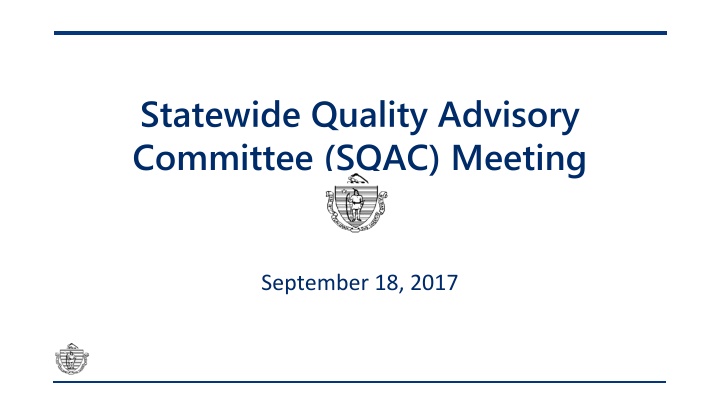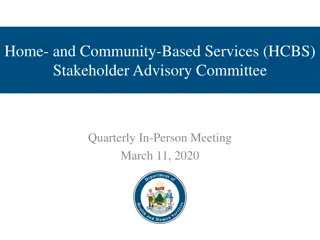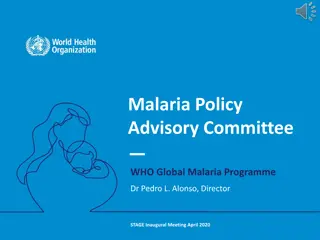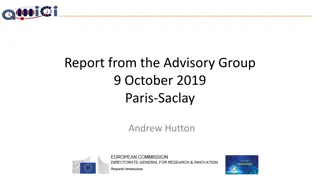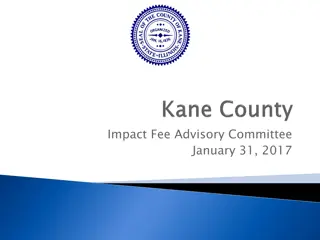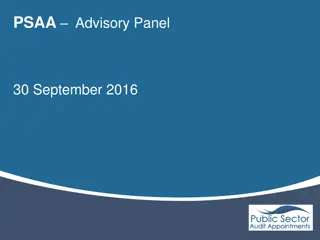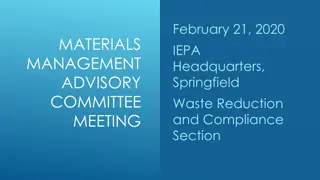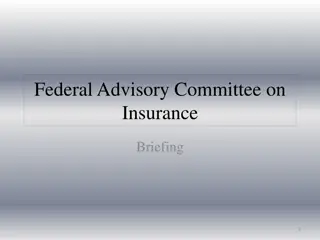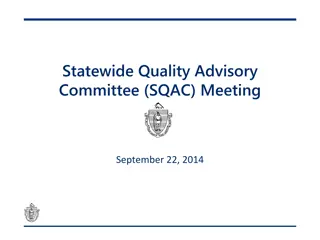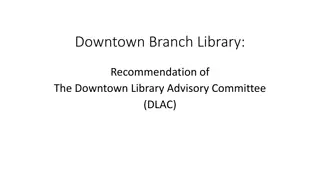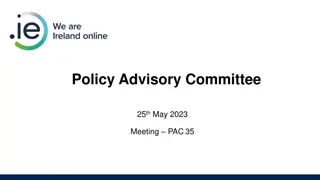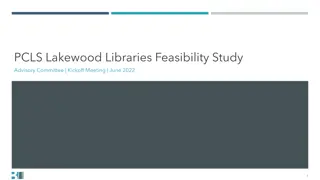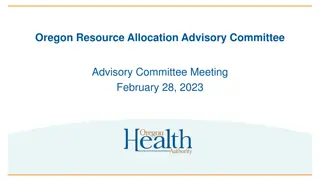Statewide Quality Advisory Committee (SQAC) Meeting Summary September 18, 2017
The Statewide Quality Advisory Committee (SQAC) held a meeting on September 18, 2017, focusing on reviewing nominated quality measures aligned with priorities such as hospital-based care, end-of-life care, and more. A total of 23 nominations were received, with scoring based on reliability, validity, amenability to improvement, ease of measurement, and field implementation. One notable measure discussed was influenza vaccination coverage among healthcare personnel. The meeting emphasized the importance of improving healthcare quality through data-driven measures and collaborations across various stakeholders.
Download Presentation

Please find below an Image/Link to download the presentation.
The content on the website is provided AS IS for your information and personal use only. It may not be sold, licensed, or shared on other websites without obtaining consent from the author.If you encounter any issues during the download, it is possible that the publisher has removed the file from their server.
You are allowed to download the files provided on this website for personal or commercial use, subject to the condition that they are used lawfully. All files are the property of their respective owners.
The content on the website is provided AS IS for your information and personal use only. It may not be sold, licensed, or shared on other websites without obtaining consent from the author.
E N D
Presentation Transcript
Statewide Quality Advisory Committee (SQAC) Meeting September 18, 2017
Agenda Welcome 3:00 3:10 - June 26 meeting minutes Review nominated quality measures 3:10 4:15 Presentation on MassHealth ACO Program 4:15 4:45 Next Steps 4:45 5:00 2
Review of Open Call for Measure Proposals Open from May 4 to June 15 Asked that measure nominations Align with the SQAC s priorities: 1. Appropriateness of hospital-based care 2. End of life care 3. Home care 4. Integration of behavioral health and primary care 5. Long term services and supports 6. Maternity care 7. Opioid use 8. Post-acute care Fill a gap in the current SQMS 3
Nominated Quality Measures Formal Survey Submissions Total of 23 nominations received 7 of these are already in the SQMS One proposal to expand an existing measure 16 new measures for consideration Nominations received from commercial payers, state agencies, providers, and researchers 4
Scoring Nominated Measures Score 0-4 Reliability & Validity How strong is the empirical evidence that the measure is reliable and valid? Minimum score: 2 Sum 0 5 (Average 0 1.25) Weak Inclusion not recommended Score 0-4 No Amenability to Targeted Improvement How reasonable is the expectation that targeted improvement on the outcome can improve the measure score? No minimum score Sum 6 8 (Average 1.5 2) Moderate Inclusion not recommended Minimum Scores Met Sum 9 12 (Average 2.25 3) Good Inclusion recommended Yes Score 0-4 Ease of Measurement How straightforward is reporting and data collection? Minimum score: 1 Sum 13 16 (Average 3.25 4) Strong Inclusion recommended Score 0-4 Field Implementation How widespread is the dissemination of the measure? Minimum score: 1 5
Influenza vaccination coverage among healthcare personnel Percentage of healthcare personnel (HCP) who receive the influenza vaccination Steward CDC Nominated by Dana Safran, BCBSMA Strong Endorsed (0431) 14 Recommended for inclusion Measure tested well. However, there is no gold standard for comparison, especially for HCP who decline vaccination. Reliability & Validity 3 Amenability to Targeted Improvement 3 Vaccination of HCP is associated with reduced work absenteeism and fewer patient deaths. HCP can voluntarily decline vaccination, hindering efforts to increase rates. Ease of Measurement 4 Already publicly reported by CMS. Field Implementation 4 Already used and publicly reported by CMS on a facility level. 6
HBIPS-1: Admission screening for violence risk, substance use, psychological trauma history and patient strengths completed Patients admitted to a hospital-based inpatient psychiatric setting who are screened within the first three days of hospitalization for all of the following: risk of violence to self or others, substance use, psychological trauma history and patient strengths. Steward Joint Commission Nominated by Dana Safran, BCBSMA Strong Endorsed (1922) 14 Recommended for inclusion All of the HBIPS measures have undergone a rigorous process of public comment and testing. Reliability & Validity 3 Amenability to Targeted Improvement 3 There is evidence to support integration of substance abuse and traditional mental health treatment, but there is no specific link between this measure and outcomes. Already used and publicly reported by TJC on a facility level, but not available on Hospital Compare. Ease of Measurement 4 Field Implementation 4 Already used and publicly reported by TJC on a facility level. 7
HBIPS-2: Hours of physical constraint The total number of hours that all patients admitted to a hospital-based inpatient psychiatric setting were maintained in physical restraint. Steward Joint Commission Nominated by Dana Safran, BCBSMA Strong Endorsed (0640) 15 Recommended for inclusion All of the HBIPS measures have undergone a rigorous process of public comment and testing. Reliability & Validity 3 Amenability to Targeted Improvement 4 There are documented interventions that facilities can take to reduce use of physical constraints. Ease of Measurement 4 Requires chart review, but is already publicly reported by CMS. Field Implementation 4 Already used and publicly reported by CMS on a facility level. 8
HBIPS-3: Hours of seclusion use The total number of hours that all patients admitted to a hospital-based inpatient psychiatric setting were held in seclusion. Steward Joint Commission Nominated by Dana Safran, BCBSMA Strong Endorsed (0641) 15 Recommended for inclusion All of the HBIPS measures have undergone a rigorous process of public comment and testing. Reliability & Validity 3 Amenability to Targeted Improvement 4 There are documented interventions that facilities can take to reduce use of seclusion. Ease of Measurement 4 Requires chart review, but is already publicly reported by CMS. Field Implementation 4 Already used and publicly reported by CMS on a facility level. 9
SUB-1: Alcohol use screening Hospitalized patients 18 years of age and older who are screened within the first three days of admission using a validated screening questionnaire for unhealthy alcohol use. Steward Joint Commission Nominated by Dana Safran, BCBSMA Good Endorsed (1661) 10 Recommended for inclusion The measure tested well, but there were meaningful numbers of exclusions due to cognitive impairment and LOS < 1 day. Reliability & Validity 3 Amenability to Targeted Improvement 2 A large number of exclusions may impact the ability to improve on scores. Evidence for screening does not examine this measure s target population. There is public reporting on 3 VA hospitals in Massachusetts, but data for other facilities would need to come from administrative data and medical records. Ease of Measurement 2 The measure is collected by TJC, but results are only available for a few hospitals in MA. Field Implementation 3 10
Median time to transfer to another facility for acute coronary intervention Median time from emergency department (ED) arrival to time of transfer to another facility for acute coronary intervention (ACI) for ST-segment myocardial infarction (STEMI) patients that require a percutaneous coronary intervention (PCI). Steward CMS Nominated by Dana Safran, BCBSMA Strong Endorsed (0290) 13 Recommended for inclusion NQF found the measure to be reliable but had limited concerns about validity due to large numbers of exclusions. Reliability & Validity 3 Amenability to Targeted Improvement 3 There is evidence to support reducing time-to-treatment for patients with AMI, but we did not find evidence that reducing time-to-transfer improves outcomes. Requires chart abstracted data, but already used and publicly reported by CMS on a facility level. However, CMS does not report scores for most hospitals. Ease of Measurement 3 Field Implementation 4 Already used and publicly reported by CMS on a facility level. 11
Aspirin at arrival Emergency department acute myocardial infarction (AMI) patients or chest pain patients (with Probable Cardiac Chest Pain) without aspirin contraindications who received aspirin within 24 hours before ED arrival or prior to transfer. Steward CMS Nominated by Dana Safran, BCBSMA Strong Endorsement Removed (0286) 14 Recommended for inclusion There are no reliability results at the measure level, but the underlying data is extensively validated and considered the gold standard. Reliability & Validity 3 Amenability to Targeted Improvement 3 NQF removed endorsment because this measure was "topped out". Evidence shows improved outcomes with immediate use of aspirin, not the first 24 hours. Ease of Measurement 4 Requires chart review, but is already publicly reported by CMS. Field Implementation 4 Already used and publicly reported by CMS on a facility level. 12
Median time to ECG Median time from emergency department arrival to ECG (performed in the ED prior to transfer) for acute myocardial infarction (AMI) or Chest Pain patients (with Probable Cardiac Chest Pain). Steward CMS Nominated by Dana Safran, BCBSMA Good Endorsement Removed (0289) 11 Recommended for inclusion Variation may exist in the assignment of ICD-10-CM codes; therefore, coding practices may require evaluation to ensure consistency. Reliability & Validity 2 Amenability to Targeted Improvement 1 NQF removed endorsement in 2014 for lack of evidence indicating that knowing the door-to-ECG time improves outcomes. Ease of Measurement 4 Requires chart review, but is already publicly reported by CMS. Field Implementation 4 Already used and publicly reported by CMS on a facility level. 13
Acute stroke mortality rate In-hospital deaths per 1,000 hospital discharges with acute stroke as a principal diagnosis for patients ages 18 years and older. Steward AHRQ Nominated by Dana Safran, BCBSMA Good Endorsed (0467) 9 Recommended for inclusion There were some concerns that hospitals may be able to artificially lower their scores by moving stroke patients to other care settings. Reliability & Validity 2 Amenability to Targeted Improvement 2 Expert panels rated the measure a 6.1 on a scale of 1-10 for overall usefulness for quality improvement within a hospital. Measure scores are not currently reported, but software to calculate measures is maintained by AHRQ and should be possible to calculate from CHIA Case Mix data. Ease of Measurement 3 The software to calculate the measure is publicly available, but measure scores are not widely reported or consistently used in performance programs. Field Implementation 2 14
Thorax CT Use of contrast material Thorax computed tomography (CT) studies that are performed with and without contrast out of all thorax CT studies performed (those with contrast, those without contrast and those with both) at each facility. Steward CMS Nominated by Dana Safran, BCBSMA Strong Endorsed (0513) 15 Recommended for inclusion Measure testing indicates strong measure reliability and expert panels rated strong face validity. Underlying Medicare claims data is extensively validated. Reliability & Validity 4 Amenability to Targeted Improvement 3 The process of identifying thorax CT studies performed concurrently is related to reduced exposure to radiation and contrast agents, and better efficiency. Ease of Measurement 4 Claims-based and already publicly reported by CMS. Field Implementation 4 Already used and publicly reported by CMS on a facility level. 15
Cardiac imaging for preoperative risk assessment for non-cardiac, low risk surgery (OP-13) Cardiac imaging studies performed at each facility in the 30 days prior to an ambulatory non-cardiac, low-risk surgery performed at any location. Steward CMS Nominated by Dana Safran, BCBSMA Good Endorsed (0669) 12 Recommended for inclusion The measure can reliably identify outliers, but is not a "gold standard" because of exclusions. The underlying claims data is extensively validated. Reliability & Validity 2 Amenability to Targeted Improvement 2 Because the measure may include some appropriate use of imaging, it is unclear what a target score would be. Ease of Measurement 4 Claims-based and already publicly reported by CMS. Field Implementation 4 Already used and publicly reported by CMS on a facility level. 16
Child HCAHPS Like other CAHPS surveys, this questionnaire focuses on aspects of pediatric inpatient care that are important to patients and their parents, and for which patients and their parents are generally the best source of information. Steward Center for Quality Improvement and Patient Safety AHRQ Nominated by Matthew Westfall, Boston Children s Hospital Good 11 Recommended for inclusion Endorsed (2548) Testing indicates that composite Child HCAHPS scores have good reliability and validity. Reliability & Validity 4 Amenability to Targeted Improvement 4 Research shows that more patient-centered care is associated with positive outcomes. Ease of Measurement 1 High resource cost: requires fielding of a patient survey. It is used in some settings (e.g. children s hospitals) but not in any public reporting or accountability programs, and may not be applicable to many MA providers. Field Implementation 2 17
Pediatric all-condition readmission measure Case-mix-adjusted readmission rates, defined as the percentage of admissions followed by 1 or more readmissions within 30 days, for patients less than 18 years old. The measure covers patients discharged from general acute care hospitals, including children s hospitals. Steward Center for Excellence for Pediatric Quality Measurement Nominated by Matthew Westfall, Boston Children s Hospital Good 10 Recommended for inclusion Endorsed (2393) There are some broad concerns about the appropriateness of all-cause readmissions measures, but the measure performed well in reliability tests. Reliability & Validity 3 Amenability to Targeted Improvement 2 There has been little evaluation of pediatric interventions to reduce readmissions, but there are effective ways to reduce readmisisons in adult populations. Data elements for measure are captured in CHIA Case Mix data, but measure is not currently calculated or publicly reported. Ease of Measurement 3 The measure is used by some providers (e.g. Boston Children's Hospital), but it is not widely implemented. Field Implementation 2 18
Prescriber prescription drug monitoring compliance Numerator: Quantity of RXs for schedule II and III where prescription drug monitoring program was checked by prescriber prior to prescribing. Denominator: Quantity of RXs for schedule II and III opioids written by independent provider. Steward MDPH Nominated by Kate Fillo, MA DPH Good Not Endorsed 12 Recommended for inclusion No reliability testing, but the metric directly measures compliance using data that is entered independently by both the prescriber and the pharmacy. Reliability & Validity 2 Amenability to Targeted Improvement 4 Evidence suggests that PDMPs are effective in combating prescription drug abuse. Data is collected by MA DPH but not publicly reported. Data sent to prescribers is used for monitoring but not for accountability or performance programs. Ease of Measurement 3 Data is collected by MA DPH and reported back to providers at the prescriber level. However, data is not publicly reported at the prescriber level. Field Implementation 3 19
Substance use disorder evaluation in the ED following naloxone administration and suspected substance use disorder Numerator: Presence of CPT codes 99408, 99409, Medicare codes G0396 or G0397, or Medicaid codes H0049 or H0050. Denominator: Corresponds to ICD-10 :T40.0-4 (x1-x4) as a diagnosis. Steward MDPH Nominated by Kate Fillo, MA DPH Weak Not Endorsed 6 Not recommended for inclusion There is currently little evidence that submissions to MA DPH align with other data sources. Reliability & Validity 0 Amenability to Targeted Improvement 2 The measure does not specify a particular screening tool, so evidence is limited. Substance abuse screening tools may be useful in driving better outcomes. MA DPH collects this data, and MA APCD, Case Mix, and EMS submissions may also be used. But these sources may conflict, making accurate measurement difficult. Ease of Measurement 2 Field Implementation 2 DPH collects this data and reports some pieces to providers. 20
SCARED: Screen for child anxiety related disorders A 41-item inventory rated on a 3 point Likert-type scale. It comes in two versions; one asks questions to parents about their child and the other asks these same questions to the child directly. The purpose of the instrument is to screen for signs of anxiety disorders in children. Steward N/A Nominated by Julianne Walsh, Bridgewater Pediatric Weak Not Endorsed 4 Not recommended for inclusion Several reviews have concluded that the tool successfully identifies depressive and disruptive disorders. Reliability & Validity 3 Amenability to Targeted Improvement 0 The tool is used to identify issues; however, there are no metrics about use of the tool or success in improving issues. This is a clinical tool, not a quality measure. Ease of Measurement 0 Extreme resource cost: survey must be administered and scored individually. Results are not publicly reported anywhere, though they may be used in individual facilities for identifying problems and planning clinical interventions. Field Implementation 1 21
Measures with a "Strong" or "Good" Rating Acute stroke mortality rate Aspirin at arrival Cardiac imaging for preoperative risk assessment for non-cardiac, low risk surgery (OP-13) Child HCAHPS HBIPS-1: Admission screening for violence risk, substance use, psychological trauma history and patient strengths completed HBIPS-2: Hours of physical constraint HBIPS-3: Hours of seclusion use Influenza vaccination coverage among healthcare personnel Median time to ECG 10 Median time to transfer to another facility for acute coronary intervention 11 Pediatric all-condition readmission measure 12 Prescriber prescription drug monitoring compliance 13 SUB-1: Alcohol use screening 14 Thorax CT Use of contrast material Mean Score Rating 2.25 Good 3.5 Strong 1 2 3 4 5 6 7 8 9 3 Good 2.75 Good 3.5 Strong 3.75 Strong 3.75 Strong 3.5 Strong 2.75 Good 3 Good 2.5 Good 3 Good 2.5 Good 3.75 Strong Measures with a "Moderate" or "Weak" Rating SCARED: Screen for child anxiety related disorders Substance use disorder evaluation in the ED following naloxone administration and suspected substance use disorder Mean Score Rating 1 2 1 Weak 1.25 Weak 22
Follow-up after hospitalization for mental illness (FUH) Dana Safran requested that health plans be able to use the Physician HEDIS specifications for facilities. The HEDIS measure is already in the SQMS. Staff recommendation for SQAC consideration: Because the denominator for this measure is based on hospital discharges, this use of the measure seems appropriate. 23
Informal Submissions (23 Measures) These measures were not formally reviewed by staff, but some information is included for your future consideration. 24
Next Steps Next Meeting October 16, 3:00-5:00 pm For more information http://chiamass.gov/sqac/ sqac@state.ma.us 25
